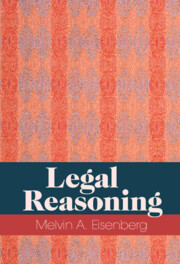Book contents
- Legal Reasoning
- Legal Reasoning
- Copyright page
- Dedication
- Contents
- Preface
- 1 A Brief Introduction to the Common Law
- 2 Rule-Based Legal Reasoning
- 3 Reasoning from Precedent and the Principle of Stare Decisis
- 4 How It Is Determined What Rule a Precedent Establishes
- 5 Reasoning from Authoritative Although Not Legally Binding Rules
- 6 The Role of Moral, Policy, and Empirical Propositions in Legal Reasoning, and the Judicial Adoption of New Legal Rules Based on Social Propositions
- 7 Legal Rules, Principles, and Standards
- 8 The Malleability of Common Law Rules
- 9 Hiving Off New Legal Rules from Established Legal Rules, Creating Exceptions to Established Rules, and Distinguishing
- 10 Analogy-Based Legal Reasoning
- 11 The Roles of Logic, Deduction, and Good Judgment in Legal Reasoning
- 12 Reasoning from Hypotheticals
- 13 Overruling
- Acknowledgments
- Index
3 - Reasoning from Precedent and the Principle of Stare Decisis
Published online by Cambridge University Press: 22 September 2022
- Legal Reasoning
- Legal Reasoning
- Copyright page
- Dedication
- Contents
- Preface
- 1 A Brief Introduction to the Common Law
- 2 Rule-Based Legal Reasoning
- 3 Reasoning from Precedent and the Principle of Stare Decisis
- 4 How It Is Determined What Rule a Precedent Establishes
- 5 Reasoning from Authoritative Although Not Legally Binding Rules
- 6 The Role of Moral, Policy, and Empirical Propositions in Legal Reasoning, and the Judicial Adoption of New Legal Rules Based on Social Propositions
- 7 Legal Rules, Principles, and Standards
- 8 The Malleability of Common Law Rules
- 9 Hiving Off New Legal Rules from Established Legal Rules, Creating Exceptions to Established Rules, and Distinguishing
- 10 Analogy-Based Legal Reasoning
- 11 The Roles of Logic, Deduction, and Good Judgment in Legal Reasoning
- 12 Reasoning from Hypotheticals
- 13 Overruling
- Acknowledgments
- Index
Summary
The foundation of most rule-based reasoning is the principle of stare decisis, meaning to stand by things decided. Under this principle, when a court decides a case that falls within a rule established in a precedent decided by a superior court or the deciding court, the court must apply that rule, subject to the limits of the principle. The best justification of stare decisis is that complex societies need a great amount of law to facilitate private planning, shape private conduct, and facilitate the settlement of private disputes. Because American legislatures do not have the capacity or ability to enact more than a limited number of private law rules, private law falls largely to the courts. Without the principle of stare decisis, rules adopted in judicial opinions would not be binding and there would be no common law.
There are several limitations on the principle of stare decisis. The most important is that in most areas of the common law if a rule established by precedent is not even substantially congruent with social morality, social policy, and experience, it may be overruled.
- Type
- Chapter
- Information
- Legal Reasoning , pp. 13 - 24Publisher: Cambridge University PressPrint publication year: 2022



